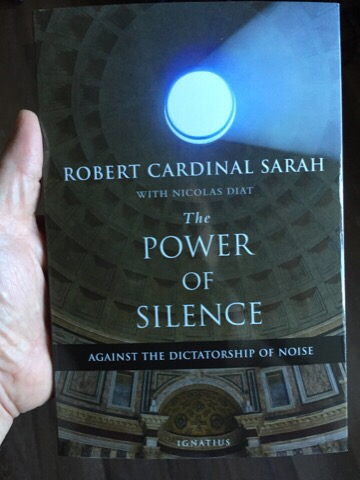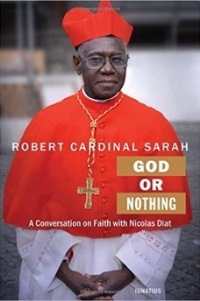 Robert Card. Sarah is quite simply terrific and profound. He opened a conference on Sacred Liturgy in Milan with clear, simple, deep, and urgent remarks about what is needed in our liturgical worship today.
Robert Card. Sarah is quite simply terrific and profound. He opened a conference on Sacred Liturgy in Milan with clear, simple, deep, and urgent remarks about what is needed in our liturgical worship today.
Read Card. Sarah’s great book The Power of Silence: Against the Dictatorship of Noise. US HERE – UK HERE
Benedict XVI wrote a new preface for the next edition of the same book. [HERE] The violence with which the liberals attacked Benedict and his preface, and Card. Sarah, demonstrates who their true master is. Sarah mentions this in his talk. One hate-filled reaction, by the execrable Andrea Grillo, is HERE.
Here is my fast rendering of what interested me the most in Sarah’s talk in Milan, as recounted by the Italian language site La Nuova Bussola.
[…]
“I pray devoutly”, Sarah said at the beginning of his talk, “for those who have the time and the patience to read this volume closely [The Force of Silence]: that God will help them to forget the vulgarity and the baseness used by some people when they referred to the “preface” and to its author, Pope Benedict XVI. The arrogance, the violence of their language, the lack of respect and the inhuman scorn for Benedict XVI are diabolical and cover the church with a mantle of sadness and of shame. These people tear down the church and her profound character. The Christian does not combat against anyone. The Christian does not have enemies to crush.”
Then the Cardinal’s talk went on, seeking to focus on the theme expressed many times by Joseph Ratzinger on the fact that the Church rises and falls in liturgy. To grasp this, he called attention to three questions: Who is Jesus Christ? How to know Jesus Christ? Who is a Christian?
Do not separate the Christ of history from the Christ of faith.
In the liturgy, “we are not celebrating the ‘Jesus of history’, nor even ‘the Christ of faith’. We recognize humbly Christ risen as God, our Lord. He mustn’t be demythologized and distanced from everything that concerns our faith: the academic value of this separation notwithstanding, that cannot be considered a legitimate undertaking in the Church’s worship. When we celebrate the sacred liturgy, we participate in the adoration of Christ made a man for our salvation, fully human and fully divine.” Therefore, Sarah emphasized, “the liturgy cannot become simply a celebration of brotherhood, but must become worship of God”.
[…]
In reference to the so-called “reform of the reform“, the Cardinal said that we must consider this question with urgency. In some places there is a separation between the”old” and the “new” (rites), this opposition cannot continue. The liturgy cannot be modified according to every ecclesiological development. The Church does not have two separate identities before and after the Council.”
Then the Cardinal recalled some words of St. Ambrose, addressed to the baptized: “remember the questions that were put to you, think back on the responses: you turned your self toward the east, because he who renounces Satan looks at Christ face to face” (De Mysteriis). “Through the use of a common physical posture of profound significance next to one’s brethren, the neophyte takes his place as a Christian in the Church’s worship. I have spoken many times about the importance of recovering this orientation, to be turned toward the East during the celebration of today’s liturgy, and I continue to sustain that which I have said. I would simply note that in these words of St. Ambrose, we can appreciate the true power, the beauty, and also the significance when we look East. Thus are we united in the Church, which turns itself toward the Lord to adore Him, in order to look at Christ ‘face to face'”.
Ultimately,” the Christian is a person who takes his rightful place in the liturgical assembly of the Church, who takes from this font the grace and instruction necessary for Christian life. These people begin to penetrate and, therefore, to live ever more the deep mysteries communicated by Sacred Liturgy. For this reason, participation in Sacred Liturgy remains essential for the Christian”.
Communion on the tongue, kneeling
“Today I would expressly recommend the reflection on and promotion of the beauty, propriety, and the pastoral value of a practice developed during the long life and tradition of the Church, that is the act of receiving Holy Communion on the tongue while kneeling. If St. Paul teaches us that, “at the name of Jesus every knee must bend in the heavens, on earth, and under the earth” (Philippians 2:10), how much more must we bend our knees when we receive the Lord in the sublime and intimate act of Holy Communion!”
To reflect on this most delicate theme the Cardinal proposed to those present. The example of two Saints: John Paul II and Mother Teresa of Calcutta. “The entire life of Karol Wojtyla was marked by a deep respect for the Holy Eucharist. (…) Today, I ask you simply to call to mind the last years of his ministry, a man marked in the body by illness, but John Paul II never sat in the presence of the Eucharist. He always forced himself to kneel. He needed the help of others to bend the knee and then rise up. Until his last days. He wanted to give us a great witness of reverence for the Most Holy Sacrament.”
Mother Theresa “surely touched daily the body of Christ present in the ruined bodies of the most poor.” However, with wonder and respectful veneration, she decided not to touch the Body of the transubstantiated Christ. Instead, she adored. She contemplated it silently. She knelt and she prostrated herself before Jesus in the Eucharist. And she received it like a little child humbly being fed by her God. Seeing Christians who receive holy Communion in their hands filled her with sadness and pain. She herself said: “when I enter into the world, the thing that saddens me the most is to see people receive communion in their hands.'”.
Sarah said he’s aware of the fact that the “present legislation contains the indult to receive the Eucharist standing and in the hand but that of receiving It kneeling and on the tongue is the norm for Catholics of the Latin Rite”.
That wound up being most of what was reported!
What a blessing Card. Sarah is for the whole Church.
 We must TURN TOWARDS THE LORD again in our sacred liturgical worship, especially during Holy Mass.
We must TURN TOWARDS THE LORD again in our sacred liturgical worship, especially during Holy Mass.
We must bend our knees and receive Communion humbly, directly on the tongue from the anointed hands of our priests.
We must find more time for silence.

 To be turned toward Christ
To be turned toward Christ



































This is where the problem lies: Western bishops know that the content in the books by Cardinal Ratzinger and Cardinal Sarah are the solutions to real meaningful liturgical renewal, but THEY LACK THE WILL to implement any of it. Our church leaders have become so fearful what the liberal zeitgeist will say about them that they are paralyzed to act. They wring their wrists and quiver in their shoes “in fear of the wolves” when they should be guiding the flock to holiness and directing our path towards the heavenly pasture. Instead, they prefer to lean on their croziers and entertain themselves watching us the sheep sink in quicksand.
God bless Cardinal Sarah. Sometimes I wonder how he manages in his position.
I agree with much of what he says here, but I have to ask, is it really true that the Church does not have two different identities before and after the Council? Yes, I agree that the Church’s true identity cannot change, but to all appearances, the identity of the Church certainly changed after the Council. In many ways, it appears that a faux church has been plastered on top of the true Church, which is in many ways hidden, but I would argue, not dormant. So what is happening here? Is Fr. Linus Clovis correct that a false church is occupying the same physical space and structure as the true Church? Are we seeing a battle between the true Church and a false church? If so, at some point we will have to see a parting of ways or a miraculous healing.
As for the urgency of reforming the reform, I think the Cardinal is right to stress that the Church is in a race against time here. In many countries in the West, the Church may only have one more generation to catechize and retain the young, or it will not be able to support its current structures and will have to start all over. If you look at the demographics, many parishes will not have the demographics to sustain them past another fifteen years or so. Sparks of light can be seen in a few more traditional NO parishes, but these are few and far between. Green shoots can also be seen in the EF communities, but many of these communities are young, not yet financially secure, and definitely at the mercy of the whims of bishops.
If, as Sr. Lucia said, the devil is in the mood to engage in a decisive battle with Mary over the Church, I would expect to see that battle heat up while the NO wing of the church is in such dire straits and the EF wing is so new and still vulnerable.
I read through #120 or so (not quite halfway) and now I’m re-reading that portion again. It’s pretty deep the first time through but opens up more both on re-reading passages and the further into it I get — a veritable gold mine. I don’t usually enjoy reading a lot of theology but this volume is great since it’s in an interview format – one question, then multiple numbered thoughts per question – and gets to the point of what we’re all wondering: Why does today’s world seem like a conspiracy to create a spiritual cesspool and how do I live in such a world and not be of it?
There was sustained, heavy applause at the end, concluding with a standing ovation. His talk was a great consolation for many.
A few days ago in a comment here, I feared I was dragging up a horse long dead by referencing 19thC “Entmythologisierung” or “demythologizing”. But it is a core pragma of Modernism and perhaps this is a moment we need to go back and review its Faith-killing strategies.
Father Ignotus says: heavy applause …a great consolation
I’m sure. I would like to have been there for it.
However, I admit that when I read your comment, something a little dire popped into my head. I was minded of the images of improptu memorials that people cobble up in the wake of terror attacks and the speeches that are made. And yet little or nothing happens afterwards.
Those who are in a position to make serious changes… do nothing. The attacks continue. So too, the Church is under attack by liberal terrorists under the direction of the Enemy.
Many of Holy Church’s officers are, demoralized, enervated, or even working for The Prince Of This World. Moreover, many lay people stop when they get a little of what they want instead of pressing forward.
I guess I am tired. I’ve been at this and tired for a long time. I don’t need consolation so much as I need to see action. Yes, we need the speeches and the memorials. We need men like Sarah to stand up, especially now. We must keep on keeping on.
MOLON LABE!
At the same time, it has been about a year since Card. Sarah issued his invitation to priests to celebrate ad orientem. Not a few priests, and even a few – too few – bishops have answered that invitation. The opposition that some of them have faced has demonstrated that Hell is not happy with this development. Let’s keep giving Hell hell.
Fr. Z, If you want to see action, you should drop by Holy Rosary Parish in Portland, liturgical flagship of the entire archdiocese. Recently the statue of Our Lady in the grotto on the north side of the Church was destroyed by vandals. No one is wringing his hands over this, least of all the pastor, Fr. Vincent, who had this insert put in the bulletin. Just for nice I am including the whole thing, which definitely bears on the reform of the reform:
OUR LADY OF LOURDES GROTTO & MORE
While the destruction of the image of our Lady was
unfortunate, this does provide us with the opportunity to
provide a larger more beautiful image of our Lady and to
restore a sculpture of St. Bernadette with the water feature. To
protect the shrine we will construct a functional, but tasteful
black wrought iron fence after the style of the original grotto in
France. That our Lady again might be a sign of hope in mid-
Portland, we do need donations large and small! We will be
accepting gifts for this project and I will be taking a few
collections. Look toward the future, we have other restorative
projects in mind including: creating images of the mysteries of
the Rosary on the blank northern external wall of the church,
restoring the side altars to liturgical use, moving the tabernacle
and altar together to create one unit, restoring the proper
number of altar steps, restoring the altar rail gates, adding some
gold leaf and bronze to the Stations of the Cross and angels in
the church, and making a mold of the original parish statue of
St. Dominic currently held at Columbia Gorge Interpretive
Center in Stevenson, WA. As previous generations left us a
monument of prayer, please consider helping us continue that
work of love which makes our beloved parish church an even
more beautiful shrine of Our Lady of the Most Holy Rosary!
–Fr. Vincent
After wide parish consultation, also with the Archbishop, with fellow Dominicans, and his superiors, Fr. has re-instituted the ad orientem celebration of every Mass. Making the tabernacle and altar one unit again will make Mass ad populum pretty much impossible, no? Well, impossible short of a new pastor bringing the wrath of the parish on his head by reinstalling an altar/ table, an eventuality which seems very unlikely. In other words, at Holy Rosary the Mass ad orientem is about to be set in stone, literally.
Thought that might encourage you a bit. . . .
“I guess I am tired. I’ve been at this and tired for a long time. I don’t need consolation so much as I need to see action.”
I am a lay person, and not been at it near as long as you but I feel the pain. I am frequently discouraged by the slow pace of change, the reluctance to ask people to do better is appalling. Priest don’t ask for modesty, they don’t ask for reverence, they don’t ask people to shed the obstacle that will block them from getting to heaven.
We are told to be grateful for the TLM once a month as proof that they are trying to be more traditional, while at the same time every public adoration and certain Masses is akin to a rock concert.
I am frustrated by the slow change and sick of not rocking the boat. The boat is going to rock.
As a layman, I find it difficult to, say, approach my new pastor and ask for some chant now and then in the parish Masses. He’s pretty orthodox, but tone-deaf, it seems, in regard to liturgy. Sometimes it feels like two different religions, the TLM and the NO culture. It’s a hard thing to bridge. Of course, most worthy things take effort!!
@Fr. Z……if I may be so bold, perhaps you could take a break from the blog once a week. The readership will get used to it. When I deployed I stepped away one day a week, and had my people do so as well, in spite of the opposition this engendered. We were better for it, I think.
—————
On the subject of turning ad orientem, at a very practical level, this will happen as an increasing number of people ask for it, pine for it, demand it.
For me this is not some abstract collision of ideas. I don’t really know personally the evil Modernists who are actively working to corrode the noble traditions of the Roman Rite. What I do see is confusion about the nature of worship. People seem to think that worship needs to be chock full of “fellowship”, nay, that worship is just another form of fellowship. And when I say people, I refer to both laity and clergy. This way of thinking is now habitual.
One of the challenges (again, on a practical level), is convincing people that turning ad orientem is NOT the death of fellowship. Rather, it is a helpful component in getting worship right, which will then provide a foundation for truly enriching fellowship.
During Lent some parishioners at St. Wenceslaus, rather than sing in Latin the Agnus Dei and Sanctus, went to mass elsewhere. Last year on 10th Sunday after Pentecost, many parishioners who had grown up in the small town did not attend the High Latin Mass, but attended the previous Saturday Mass. (This writer saw that Sunday many faces new to him. A number of people came from about 80 miles away, and their usual Sunday noon TLM, when their priest, knowing St. Wenceslaus had a high Mass scheduled, took a week off and pointed them towards
So perhaps Bishops and higher ups are falling short; they are not the only ones.
Wow. Most impressive churchman hands down. I am adjusting to that not necessarily being the pope, having been born in 1983.
From Cardinal Sarah: Criticisms of Benedict XVI are ‘diabolical’, by Nick Hallett, for Catholic Herald:
Cardinal Robert Sarah has hit out at critics of Pope Emeritus Benedict XVI, accusing them of “vulgarity and baseness” in their criticisms of the former pope’s preface to the cardinal’s latest book.
“The arrogance, the violence of language, the disrespect and the inhuman contempt for Benedict XVI are diabolical and cover the Church with a mantle of sadness and shame,” Cardinal Sarah said.
“These people demolish the Church and its profound nature.”
Thank you for the ‘fast rendering’ Father Z–powerful and courageous words from Cardinal Sarah!
(Google translate gave the St Ambrose quote from ‘De Mysteriis’ the exact opposite meaning-so I was startled for a minute)
Signs of reverence change with time and culture. In most of our Western societies standing is the form of respect. So standing for the reception of Holy Communion is an appropriate act of respect and reverence. [B as in B. S as in S.]
I see no reason why Communion in the hand is any less reverent than on the tongue. [Risible.]
Where to start? Where I live, the bricks are coming down, not going up. An order of priests which has at least had a semblance of solid liturgical practices is leaving the diocese and, with them, the First Friday TLM. There a small mission church inconveniently located which has the TLM. It is bursting at the seams (to be clear, it legally accommodates 85 skinny people but over one hundred are stuffing themselves in every Sunday for the only TLM Sunday Mass in the diocese). This place is so universally ignored that it isn’t even listed on the list of churches in the local diocesan publication. There is absolutely no support from the diocese. My choir, which is quite good, had to become an independent choir because of the reality of suppression at two different parishes. The choir sings chant propers (the three permitted in NO Masses where these things are allowed), polyphonic Masses which are only permitted on Christmas, Easter and Pentecost and is pretty universally regarded as somewhat nutty, especially the director. Not one diocesan priest is interested in learning the TLM. At present, the choir cannot fit into the TLM chapel because of lack of space. In one year, the order will be gone and the probability of being able to sing most of our repertoire will be gone with them. Cardinal Sarah’s remarks are spot on, of course. He is a brave man. But what is one to do when there is nowhere left to turn? I have put this in the hands of St. Joseph. Surely we will not again be left orphans, as has happened before. It is hard to reconcile what he says with the reality of the current situation. And we are not unique by any stretch. Please help us to pray that we will be sent a good, holy priest who understands solid liturgical practices.
After a very long time indeed I received my copy of “The Power of Silence”. I began reading it straight away. Wow! What a wonderful book!
@HighMass….Good test; proceed.
Joekstl, when sitting, while eating, after an ordination Mass, and the Bishop approaches, to shake ones hand, stand.
Receiving Christ in the hand is to stand up as He enters, slap Him on the back, and say “How-deeeee”.
When Christ Himself appears, kneel. Familiaritas parit contemptum.
Pingback: Cardinal Sarah’s stellar talk on urgent needs for our sacred liturgical worship |
Pingback: THVRSDAY CATHOLICA EDITION | Big Pulpit